Results for: martin jenkins
Below is a list of 11 the books by this author.
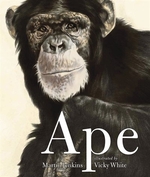
APE
By: martin jenkins | Published: September 2010
"White makes an intense emotional connection between subject and reader. . . . The great apes have found their John Singer... [Read More]
"White makes an intense emotional connection between subject and reader. . . . The great apes have found their John Singer Sargent." — Publishers Weekly (starred review) A Book Sense Children’s Pick A Bank Street College Best Children’s Book of the Year A New York Public Library: 100 Titles for Reading and Sharing Selection An ASPCA Henry Bergh Children’s Book Award Winner Swing with a hairy orangutan and her baby as they lunge for a smelly, spiky durian fruit. Roam and play with a gang of chimps, then poke out some tasty termites with a blade of grass. Chatter and feast on figs with a bonobo, or chomp on bamboo with a gorilla as he readies for sleep. What could be better than spending time with these rare and wonderful creatures — after all, the fifth great ape on this planet is you! Back matter includes an index and a map.
Theme: Science
- ISBN
9780763649746 - Binding
Paperback - Category
Science - Animals
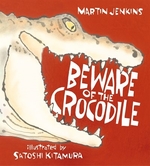
BEWARE OF THE CROCODILE
By: martin jenkins | Published: March 2019
Explore an informative, playfully illustrated story about one of the world’s most dangerous animals: the crocodile. You probably know a... [Read More]
Explore an informative, playfully illustrated story about one of the world’s most dangerous animals: the crocodile. You probably know a little about crocodiles already. They’re reptiles, they have an awful lot of teeth, and they’re pretty scary — at least, the big ones are! They’re not very fussy about what they eat, and when it comes to hunting down dinner, crocodiles are very determined . . . and very cunning. But there’s more to crocodiles than just their appetites. They love to nap on warm sandbanks and cool off in calm waters, and crocodile mothers are very gentle with their babies. This fascinating look at one of Earth’s most infamous creatures is full of information for amateur scientists, with back matter that includes an index, notes on species, and suggestions for further reading.
- ISBN
9780763675387 - Binding
Hardcover - Category
Science - Animals
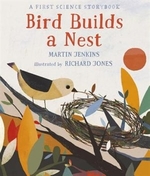
BIRD BUILDS A NEST - 1ST SCIENCE STORYBO
By: martin jenkins | Published: February 2018
A gentle, sweetly illustrated concept book takes on physical forces as young children learn about pushing and pulling. It’s time for Bird to... [Read More]
A gentle, sweetly illustrated concept book takes on physical forces as young children learn about pushing and pulling. It’s time for Bird to build her nest! Follow her as she pulls a worm out of the ground, lifts some twigs that are just the right size, and pushes the twigs into place. Uh-oh! One of the twigs falls to the ground! But after a day of hard work, Bird’s nest is ready and waiting. Can you guess what it’s waiting for? Using simple, clear language and beautiful illustrations, this engaging story is the perfect introduction to physical forces for very young readers. A final spread with some simple questions promotes discussion with parents, teachers, or caregivers and encourages readers to think about the concepts introduced.
Theme: Science , Kindergarten
- ISBN
9780763693466 - Binding
Hardcover - Category
Picture Book
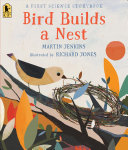
BIRD BUILDS A NEST - 1ST SCIENCE STORYBO
By: martin jenkins | Published: March 2020
A gentle, sweetly illustrated concept book takes on physical forces as young children learn about pushing and pulling. It's time for Bird to build... [Read More]
A gentle, sweetly illustrated concept book takes on physical forces as young children learn about pushing and pulling. It's time for Bird to build her nest! Follow her as she pulls a worm out of the ground, lifts some twigs that are just the right size, and pushes the twigs into place. Uh-oh! One of the twigs falls to the ground! But after a day of hard work, Bird's nest is ready and waiting. Can you guess what it's waiting for? Using simple, clear language and beautiful illustrations, this engaging story is the perfect introduction to physical forces for very young readers. A final spread with some simple questions promotes discussion with parents, teachers, or caregivers and encourages readers to think about the concepts introduced.
- ISBN
9781536210569 - Binding
Paperback - Category
Picture Book
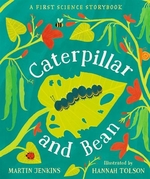
CATERPILLAR & BEAN - 1ST SCIENCE STORYBO
By: martin jenkins | Published: April 2019
Observe the ways plants and insects interact in a gentle introduction to growing for budding scientists. What’s that wedged in a crack in... [Read More]
Observe the ways plants and insects interact in a gentle introduction to growing for budding scientists. What’s that wedged in a crack in the ground, small and hard and wrinkly and brown? A bean seed! Soon it develops roots and leaves. And what’s that on the leaf? An egg! The egg hatches a caterpillar, and the caterpillar eats the leaves, getting bigger and bigger until it forms a chrysalis. Meanwhile, the plant is growing, too: it develops flowers, then bean pods, as it reaches up toward the sun. Side by side, plant and insect grow . . . and grow . . . and grow throughout the year, until they come full circle. This fourth book in the First Science Storybook series uses simple, clear language and colorful illustrations to inspire very young readers as they learn about life cycles.
- ISBN
9781536201703 - Binding
Hardcover - Category
Science - Insects & Spiders
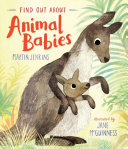
FIND OUT ABOUT ANIMAL BABIES
By: martin jenkins | Published: April 2022
A conservation biologist looks at some of the many kinds of animal babies--and the many ways their parents take care of them--in a gentle... [Read More]
A conservation biologist looks at some of the many kinds of animal babies--and the many ways their parents take care of them--in a gentle introduction for young children. Some animals have big babies (did you know a newborn whale weighs three tons?). And some animals have babies that are small (a new kangaroo, less than an inch long, climbs into its mother's pouch to stay safe and warm). All animals have babies, but not all animal babies are the same, and not all animal parents are the same, either. From parents whose babies look just like them to those with no resemblance at all, from parents who raise their young in a crowd to those who do it all on their own, the range of family setups depicted here shows just how much the lives of animal babies can vary from the time they're born. Melding a simple narration with more detailed facts on a variety of creatures from leopards to lizards, elephants to sea turtles, butterflies to chimpanzees, fish to flamingos, this fascinating picture book also offers a brief note on animal parents and babies in the back matter.
- ISBN
9781536220469 - Binding
Hardcover - Category
Science - Animals
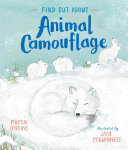
FIND OUT ABOUT ANIMAL CAMOUFLAGE
By: martin jenkins | Published: October 2023
Discover some of the brilliant ways animals disguise themselves in this engaging introduction for young children from a conservation biologist. Some... [Read More]
Discover some of the brilliant ways animals disguise themselves in this engaging introduction for young children from a conservation biologist. Some animals hide in the sand, like the desert lizard, whose scales can resemble pebbles and stones. Others hide in the sea, like the peacock flounder, who can also change color. And some, like poison dart frogs and the scarlet king snake, don't try to hide at all! Most animals have developed clever tricks to survive, but not all excel at camouflage the way these animals do. From moths whose wings resemble dead leaves to eponymous stick insects, from a lizard that looks like a tree stump to the ghost pipefish you'd mistake for a coral reef, the range of colors, patterns, and techniques captured here demonstrates how animals across myriad environments can disguise themselves. Melding a simple narration with more detailed facts on a variety of creatures--including sandgrouses, gerbils, Arctic foxes, and butterflies--this fascinating picture book also offers a brief note on animal camouflage in the back matter.
- ISBN
9781536228366 - Binding
Hardcover - Category
Science - Animals
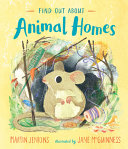
FIND OUT ABOUT ANIMAL HOMES
By: martin jenkins | Published: April 2022
Discover some of the many types of animal homes in this engaging introduction for young children from a conservation biologist. Some animals make... [Read More]
Discover some of the many types of animal homes in this engaging introduction for young children from a conservation biologist. Some animals make houses out of sticks (storks will return to their large twiggy nests year after year). Others build them out of stones (young caddis flies carry their pebbly homes wherever they go). And some--like edible-nest swiftlets--craft houses out of spit! Many animals have homes, but not all animal homes are the same. From honeybees with neat, precise hives to pack rats with messy nests, from prairie dogs whose underground towns last for decades to orangutans who make a new home every day, the range of dwellings depicted here shows how much animals' behavior can vary, even in their own homes. Melding a simple narration with more detailed facts on such animals as beavers, spiders, polar bears, termites, and reindeer, this appealing picture book also offers a brief note on animals and their homes in the back matter.
- ISBN
9781536220476 - Binding
Hardcover - Category
Science - Animals
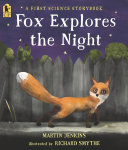
FOX EXPLORES THE NIGHT - 1ST SCIENCE STO
By: martin jenkins | Published: October 2022
Young readers are invited to join a determined fox as she sets out to find her dinner in this simple, stylish introduction to light and dark. Fox is... [Read More]
Young readers are invited to join a determined fox as she sets out to find her dinner in this simple, stylish introduction to light and dark. Fox is hungry. She waits until dark, then emerges from her den to hunt for food. Follow her as she pads through the city streets and learns about sunlight, moonlight, and electric light. Shadows grow along alleys and reflections bounce off store windows as Fox moves through patches of light and dark. Using simple, clear language and beautiful illustrations, this gentle story is the perfect introduction to light and dark for budding scientists.
- ISBN
9781536227765 - Binding
Paperback - Category
Science - General
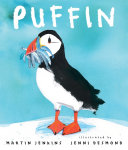
PUFFIN
By: martin jenkins | Published: November 2022
Take a first look at this appealing northern bird--and follow one diligent pair as they nurture their new chick. Everyone recognizes the puffin, with... [Read More]
Take a first look at this appealing northern bird--and follow one diligent pair as they nurture their new chick. Everyone recognizes the puffin, with its black and white feathers and brightly colored bill. But how does the puffin live? What happens down in its burrow? And how do the male and female share the task of feeding and caring for their young? Discover the intriguing world of this charming bird in a collaboration that pairs Martin Jenkins's engaging, informative text with the warm energy of Jenni Desmond's illustrations. Filled with interesting facts, this delightful introduction to the puffin offers young ornithologists more details in the back matter.
- ISBN
9781536228502 - Binding
Hardcover - Category
Science - Birds

WALK THROUGH THE RAIN FOREST
By: martin jenkins | Published: October 2022
The award-winning team behind Can We Save the Tiger? and Ape invites young readers to explore the breathtaking biodiversity of a Malaysian tropical... [Read More]
The award-winning team behind Can We Save the Tiger? and Ape invites young readers to explore the breathtaking biodiversity of a Malaysian tropical rain forest. Conservation biologist Martin Jenkins and acclaimed fine artist Vicky White expertly guide readers into the complex ecosystem of Malaysia's Taman Negara. Conversational prose and photorealistic black-and-white artwork--punctuated by four jaw-dropping full-color spreads--evoke the whir of cicadas and the low call of a pheasant. Pages fill with ants and elephants, leopards and hornbills, gibbons and bats, as animals spread and fertilize seeds to help maintain a magnificent old-growth forest. Every living thing in the rain forest is interconnected, and a dazzling full-color index guide at the end of the book challenges readers to circle back and marvel at animals they may have missed in the dense foliage. Meticulously researched and visually arresting, this creative tour de force is a young conservationist's dream: the ecotour of a lifetime.
- ISBN
9781536211207 - Binding
Hardcover - Category
Science - Animals
